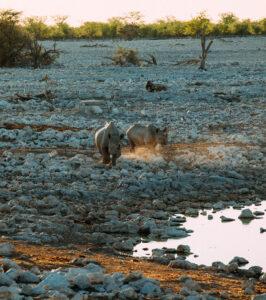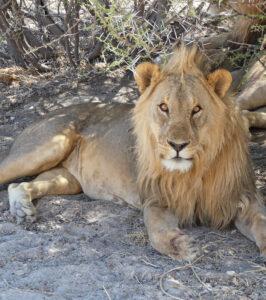Etosha National Park
22,270 sq. km (8,600 sq. mi)
1958 (protected wildlife area) | 1967 (national park)
June to October
The Great White place
Etosha National Park is one of the most unique wildlife sanctuaries in the world. The vast plains upon which zebra and springbok can be seen in large numbers and the congregation of various animal species at its many waterholes make the Etosha National Park one of the best safari destinations in Africa.

Namibia Safari in Etosha National Park: Wildlife and waterholes
For those who wish to see wildlife on their Namibian journey, the Etosha National Park is a must visit destination. It is the most popular national park in Namibia and can provide fantastic wildlife moments to those who explore it.
On an Etosha safari it is common to encounter large numbers of elephant, giraffe, zebra, wildebeest as well as a host of antelope species including springbok, oryx, kudu and impala. The predator that is most often seen and heard is the lion. Etosha’s apex predator is most active just after dusk or in the early hours of the morning. Harder to spot are leopard and cheetah, though both are present in the park.
Every animal has a story to tell and nowhere is this truer than in the Etosha. For example, when you look carefully you will discover that there are two different species of zebra living in the Etosha National Park. You can find the common plains zebra as well as the Hartmann’s mountain zebra, the latter of which is by far the rarer of the two. The Hartmann’s mountain zebra has adapted to survive in rocky and mountainous areas and it is regularly sighted in the western Etosha.
Birders can look forward to 340 species of birds on their Namibia safari in Etosha National Park. A third of these species are migratory and the most popular is probably the European bee-eater. The 35 raptor different species include several types of vultures, as well as eight species of owl. Larger birds found in the park are ostrich and the world’s heaviest flying bird, the kori bustard.
The secret to the success of the Etosha is its many waterholes, most of which provide water throughout the year to the thirsty animals. These include both natural fountains and springs as well as artificial boreholes. It is quite common to witness multiple animal species, even predator and prey alike, sharing a waterhole simultaneously and this has the makings of a tremendous wildlife spectacle. Famous waterholes in the Etosha include Nebrownii, Okaukuejo, Rietfontein, Goas, Kalkheuwel and Namutoni.
The huge Etosha Salt Pan is certainly also worth a visit. At 130 km long and up to 50 km wide in places, it is comfortably the largest salt pan in Africa and is the park’s most distinctive and dramatic feature, visible even from space. It is so quiet you can hear your thoughts and so vast that your eyes can gaze over the flat landscape all the way unto the horizon. During periods of heavy rain, the Etosha salt pan can fill with water and flamingos flock to this temporary lake to harvest on the blue and green algae which form, creating an oasis in middle of this otherwise dry environment.
Etosha is malaria free in the dry winter months, but most international health organizations still advise on taking some form of prophylaxis during this time as well as during the wetter summer months, roughly from December to April. The best game viewing is in the dry season, roughly from June to October, where daytime temperatures are cooler (but still pleasantly warm). The green season can get very hot, but it is also the better season for birders.
The park is entirely accessible to two-wheel drive vehicles and offers plenty of accommodation options, both camping and lodging, inside the park and near the park’s entrance gates. You can explore Etosha on a self-drive safari or a guided tour. The lodges inside the park are state-run and give you the opportunity to go on guided night games, whilst the accommodations outside of the park’s boundary often are more intimate and charming.
The Etosha National Park offers you a safari experience unlike any other. By exploring this immense wildlife sanctuary, you can get a fantastic insight into the lives of the many animals who play an important part in Namibia’s greater ecosystem. Even if you have visited the Etosha before, it remains a fantastic national park to revisit as you will never know what it has in store for you this time around.
Excellent game viewing
You can witness a great number of large mammals, including four of the ‘Big Five’ (only buffalo is missing) as well as many other animals, some of which are considered rare or endangered.
Unique landscapes
You will understand why the word Etosha derives from a local word meaning ‘great white place’ and is likely in reference to the enormous 4,800 sq. km large salt pan in the heart of the National Park.
Floodlit waterholes
You can relax at Okaukuejo’s floodlit waterhole which puts large mammals such as black rhino, elephant, lion and giraffe literally in the spotlight.
WHEN TO GO
Best time to go to Etosha National Park
You can go on an Etosha tour at any time of year, although many will argue that the best time of year to visit the Etosha is during the dry winter months. Water is scarce at this time, forcing the various animals to come to the waterholes to drink. This allows you to experience fantastic wildlife moments. The green season also has its rewards, as the park presents itself at its most beautiful during this time. Animals look their happiest and plumpest during the green season, which always makes for a lovely sight.
Dry Season
May to NovemberBest for wildlife viewing at the waterholes
Green Season
December to AprilBest for birding and beautiful landscapes
Why to go
See the "Ghosts of Etosha"
The elephants of Etosha like to cake themselves in mud to protect themselves from the harsh Namibian sun and when this mud dries, it gives them an eery white appearance. These white elephants are a magnificent sight, particularly when contrasted against the deep blue sky in the background.


We will always remember that lion in Etosha National Park. Each night, he roared loudly. Such experiences in the wild, while staying in a tent, are unique.Gengenbacher Family | Tailor-Made Tour
Where to stay in Etosha National Park
Location
The Etosha National Park is located in the north of Namibia. The park has four entrance points and is open all year, from sunrise to sunset. The entrance gates are the Anderson Gate in the south, the Von Lindequist Gate in the east, the King Nehale Gate in the north and the Galton Gate in the west.



Experience Namibia with us
Speak to one of our local advisors
Let's start planning your trip!
We will get back to you within 2 working days.




























